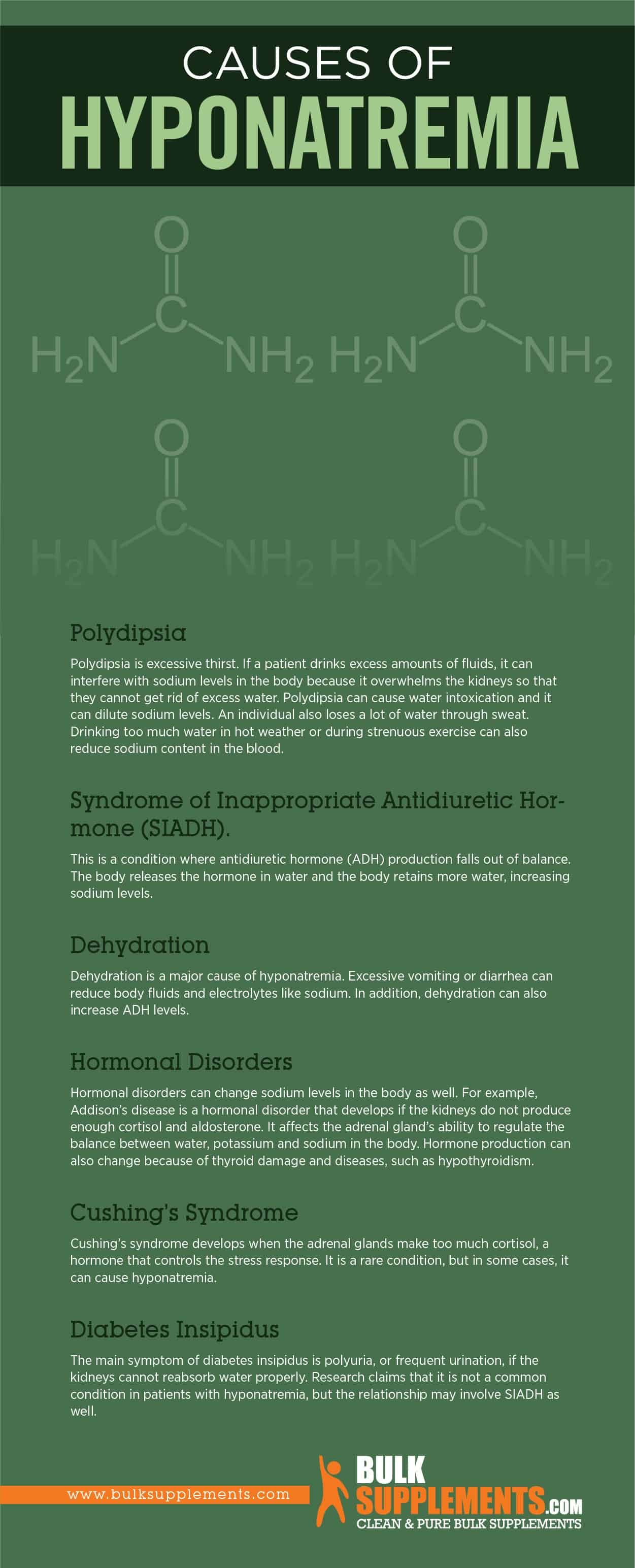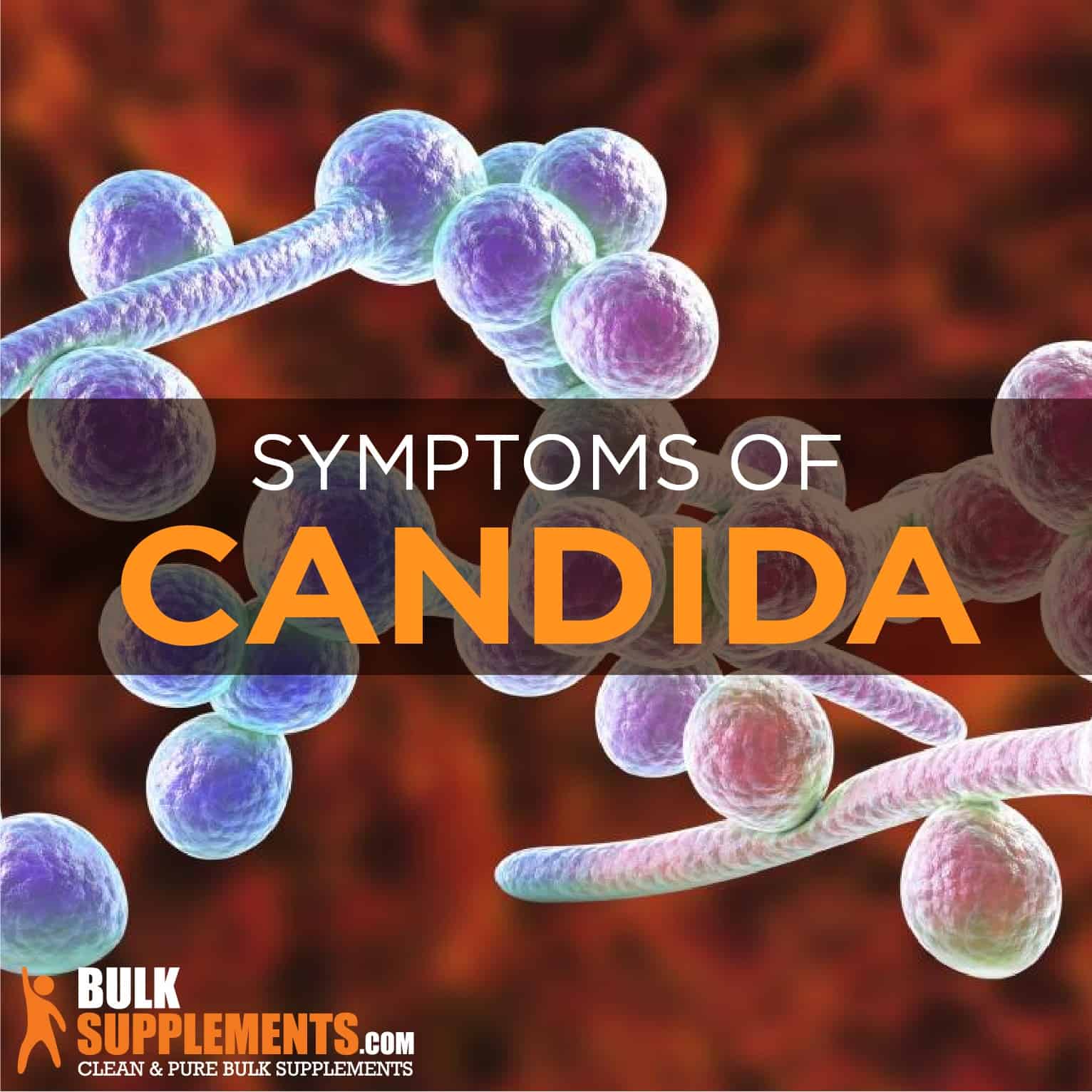Hyponatremia: Causes, Symptoms & Treatment

Hyponatremia
What is Hyponatremia?
Hyponatremia is a condition that occurs when water and sodium levels fall out of balance in the body. Sodium is an important electrolyte that helps maintain proper nerve and muscle function. It also helps regulate blood pressure and water balance in and around the cells. However, in hyponatremia the patient’s water levels might be too high or their sodium levels might be too low. Normally, sodium levels should fall between 135 and 145 milliequivalents per liter (mEq/L). Hyponatremia develops when the sodium drops below 135 mEq/L.
Patients often develop hyponatremia after admission to a hospital if they receive intravenous fluids. Surveys show that hyponatremia occurs in 15 to 30 percent of patients during their stay in a hospital. In hyponatremia, several factors combine to reduce sodium levels in the body, from underlying health conditions to drinking too much water. Certain medicines can also reduce sodium levels, such as diuretic medicines and antidepressants. Vomiting, sweating, diarrhea and liver cirrhosis can also cause low blood sodium.
When sodium levels in the body are low, water gets into the cells and causes them to swell. This can cause many problems ranging from mild to severe. However, symptoms vary from individual to individual. If the sodium levels fall gradually, the patient may not experience any symptoms. But if sodium levels drop quickly, the symptoms can be more severe and the condition may turn into a medical emergency. Treatment for hyponatremia involves regulating fluid levels in the body and balancing sodium and water intake and excretion.
Types of Hyponatremia
Physicians categorize hyponatremia into several types depending on the cause:
Euvolemic Hyponatremia
This is the most common type of hyponatremia that patients report during their stay in hospitals. Syndrome of inappropriate antidiuretic hormone secretion (SIADH) is the most common cause of euvolemic hyponatremia. In this form of hyponatremia, water levels increase, which reduces sodium levels in the blood.
Hypovolemic Hyponatremia
In this form of hyponatremia, both water and sodium levels are low. This develops from high antidiuretic hormone (ADH) level secretion in hypovolemic states, which increases water reabsorption.
Hypervolemic Hyponatremia
This form of hyponatremia is characterized by a paradoxical rise in total body sodium. However, the total body water increases simultaneously and proportionally, causing dilutional hyponatremia. It is caused by underlying pathologies like cirrhosis, congestive cardiac failure and nephrotic syndrome.
Chronic Hyponatremia
Chronic hyponatremia occurs after about 48 hours. It is riskier because it can cause possible complications and it may also be difficult to treat. If chronic hyponatremia progresses very rapidly, physicians refer to it as acute hyponatremia. Acute hyponatremia is easier to control with treatments like intravenous fluids.
Hyponatremia Symptoms
Hyponatremia symptoms may vary from mild to severe depending on the level of swelling and fluid retention. Common symptoms of low blood sodium include:
Complications from Hyponatremia
Osteoporosis
Hyponatremia can also lead to osteoporosis, which increases the risk of bone fractures. One study showed that the possibility of developing osteoporosis may be significantly greater among adults with mild hyponatremia than those without it.
Brain Damage
Severe cases may be a medical emergency and may cause coma, seizures, cardiopulmonary arrest, loss of consciousness and even death. It can also cause a condition called cerebral edema, swelling in the brain that can cause brain damage because it puts pressure on the brain and the skull. Cerebral edema only happens in severe cases of hyponatremia. Difficulty concentrating, confusion, irritability, memory problems, seizures, difficulty speaking and mood swings are all signs of cerebral edema.
Causes of Hyponatremia
Polydipsia
Polydipsia is excessive thirst. If a patient drinks excess amounts of fluids, it can interfere with sodium levels in the body because it overwhelms the kidneys so that they cannot get rid of excess water. Polydipsia can cause water intoxication and it can dilute sodium levels. An individual also loses a lot of water through sweat. Drinking too much water in hot weather or during strenuous exercise can also reduce sodium content in the blood.
Syndrome of Inappropriate Antidiuretic Hormone (SIADH).
This is a condition where antidiuretic hormone (ADH) production falls out of balance. The body releases the hormone in water and the body retains more water, increasing sodium levels.
Dehydration
Dehydration is a major cause of hyponatremia. Excessive vomiting or diarrhea can reduce body fluids and electrolytes like sodium. In addition, dehydration can also increase ADH levels.
Hormonal Disorders
Hormonal disorders can change sodium levels in the body as well. For example, Addison’s disease is a hormonal disorder that develops if the kidneys do not produce enough cortisol and aldosterone. It affects the adrenal gland’s ability to regulate the balance between water, potassium and sodium in the body. Hormone production can also change because of thyroid damage and diseases, such as hypothyroidism.
Cushing’s Syndrome
Cushing’s syndrome develops when the adrenal glands make too much cortisol, a hormone that controls the stress response. It is a rare condition, but in some cases, it can cause hyponatremia.
Diabetes Insipidus
The main symptom of diabetes insipidus is polyuria, or frequent urination, if the kidneys cannot reabsorb water properly. Research claims that it is not a common condition in patients with hyponatremia, but the relationship may involve SIADH as well.

Risk Factors for Hyponatremia
Some factors may not directly cause the condition, but they can increase a patient’s risk for hyponatremia. These factors include:
Drugs and Medications
There are certain medications that increase the risk of hyponatremia including antidepressants, pain medications and diuretics. These medications can interfere with normal hormonal kidney processes that maintain healthy sodium concentrations. Research also connects the condition to recreational drug use with ecstasy and other amphetamines.
Intense Physical Activity
Regularly engaging in intense and vigorous physical activities like marathons, triathlons or ultra marathons tends to lose large amounts of body fluids through sweat. Losing body fluid can cause the individual to drink too much water to compensate for the water they lose, which can increase the risk for hyponatremia.
Heart, Liver & Kidney Problems
Diseases that affect the kidneys and the liver and congestive heart failure can cause fluid buildup in the body. These fluids may dilute sodium in the blood, lowering sodium levels.
Diagnosing Hyponatremia
Hyponatremia symptoms can vary widely from person to person. Patients who experience any symptoms should seek medical care, as they may require urgent medical treatment. To diagnose low blood sodium levels, a doctor may ask about the patient’s medical history, health conditions and medications they take. The doctor may also carry out a physical exam and order a blood test. Blood tests can assess blood concentration, urine content and the amount of fluids in the body. If the blood tests indicate low sodium levels, the doctor may perform additional tests to determine the cause.
SEE ALSO

Candida: Symptoms, Causes & Treatment
Hyponatremia Treatment
There are multiple treatments for hyponatremia depending on the underlying cause.
Restoring Blood Sodium Levels
Patients with mild to moderate hyponatremia from medications or lifestyle factors may be able to raise their sodium to normal levels by switching medications, adjusting medication doses and taking fewer fluids.
However, individuals with severe symptoms may need intravenous sodium treatment and hospitalization to help raise sodium levels back to normal. They may also need medicines to treat hyponatremia symptoms and complications, such as seizures.
Electrolytes & Fluid Intake
Those who perform strenuous exercise should consider drinking water with electrolytes. This can help balance electrolytes in the body during physical activity when the patient loses fluid through sweat. Taking electrolytes may also help prevent hyponatremia in the first place.
Treating the Underlying Cause
If an underlying medical condition or hormonal disorder causes hyponatremia, the patient may require treatment for that specific condition. For example, patients with heart, kidney or liver disease may need medications or surgery. Kidney problems may require dialysis and heart disease or liver problems may require surgery or a transplant.
Individuals with thyroid disorders may be able to manage hyponatremia and other complications with lifestyle changes and medications. SIADH usually requires regular treatment to manage hyponatremia. People with this condition may need to take salt tablets or medications or restrict their fluid intake.
Supplements for Hyponatremia
Vitamin C/Sodium Ascorbate
Vitamin C is a very common tool to strengthen the immune system. Another name for vitamin C is sodium ascorbate. It can help treat and protect the body from illness, such as colds and flu. It also helps produce collagen, which keeps the skin and joints healthy. Taking vitamin C can help strengthen bones which may become damaged with chronic hyponatremia. It is also an antioxidant that helps with overall immune health. As a dietary supplement take 2,100 mg of sodium ascorbate powder once a day with meals, or as a physician instructs.
Sodium D-Aspartate
Sodium D-aspartate is also called aspartic acid. It is an amino acid derived from sodium and its main role is to improve metabolism, which may help with hyponatremia. It can also help strengthen the muscles, reduce fatigue and produce glucose for energy. Aspartic acid can also strengthen the immune system and eliminate toxins from the body. As a dietary supplement, take 3,000 mg (about 1 tsp) of sodium D-aspartate powder once daily, or following a physician’s instructions.
Bottom Line
Hyponatremia is an electrolyte imbalance that results in low sodium levels in the body in proportion to water levels. Symptoms of hyponatremia include vomiting, nausea, weakness, headaches, confusion and fatigue. In severe cases, patients may suffer complications like seizures, coma and brain damage from swelling. Treatments for hyponatremia aim to raise sodium levels in the blood. Patients may manage their fluid intake, take electrolytes and attempt to balance hormone levels. However, if the condition is a result of an underlying health condition such as heart, liver or kidney problems, the patient may require additional treatment for that underlying condition.
Patients may also try supplements to help balance sodium and water levels in the blood, including sodium ascorbate powder and sodium D-aspartate. However, supplements are not a cure for hyponatremia or any other medical condition. Instead, they aim to improve overall health. Always consult a doctor before adding supplements to a health regimen and follow a physician’s instructions.



